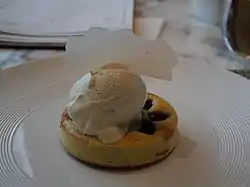Clafoutis
Clafoutis (French pronunciation: [klafuti]; Occitan: clafotís [klafuˈtis] or [kʎafuˈtiː]), sometimes spelled clafouti in Anglophone countries, is a baked French dessert of fruit, traditionally black cherries,[1] arranged in a buttered dish and covered with a thick flan-like batter. The clafoutis is dusted with powdered sugar and served lukewarm, sometimes with cream.
 Blueberry Clafoutis with ice cream | |
| Course | Dessert |
|---|---|
| Place of origin | France |
| Region or state | Limousin |
| Serving temperature | Warm |
| Main ingredients | Flan batter, black cherries, powdered sugar |
| Variations | Flaugnarde |
| Other information | It can also be made with apples, pears, etc. |
A traditional Limousin clafoutis contains not only the flesh of the cherries used, but also the nut-like kernels in the stones.[2] Cherry kernels contain benzaldehyde, the compound responsible for the dominant flavour in almond extract.[3] They also contain a small amount of amygdalin, a cyanogenic glycoside - a compound potentially capable of releasing cyanide if consumed, but non-toxic in small quantities.[4]
Origins
The clafoutis comes from the Limousin region of France, and while black cherries are traditional, there are numerous variations using other fruits, including red cherries, plums, prunes, apples, pears, cranberries or blackberries.[5] When other kinds of fruit are used instead of cherries, the dish is properly called a flaugnarde.
The dish's name derives from Occitan clafotís, from the verb clafir, meaning "to fill" (implied: "the batter with cherries").[6] Clafoutis apparently spread throughout France during the 19th century.
Cultural References
In the film "First Cow" (2019), "Cookie" Figowitz bakes a blueberry clafoutis for a visiting ship's Captain in the wilderness of mid 19th century Oregon. In her autobiographical novel The War: A Memoir French resister and writer Marguerite Duras carefully gathers up the rationed ingredients to make her husband a clafoutis when he returns from the concentration camps, only to find that he is too weak from malnutrition and exposure to eat it.[7]
References
- Wells, Patricia (1991). Simply French. New York, N.Y.: William Morrow and Company, Inc. p. 276. ISBN 9780688066420. OCLC 23771182.
- "Clafoutis". The Concise Larousse Gastronomique: The World's Greatest Cookery Encyclopedia (Revised ed.). London: Hamlyn, a division of Octopus Publishing Group. 2003-04-15 [1998]. p. 311. ISBN 978-0600608639.
- "cherry clafoutis – A Toast and Tea". A Toast and Tea. July 6, 2011. Retrieved June 5, 2019.
- Nick, Jean (July 25, 2018). "Are Stone Fruit Seeds Poisonous? What to Know About Cherry, Peach, and Plum Pits". Good Housekeeping. Retrieved June 5, 2019.
- Larousse Gastronomique, Clarkson Potter Publishers
- The Oxford Companion to Sugar and Sweets. Oxford University Press. 2015-04-01. ISBN 9780199313617.
- Duras, Marguerite (1985). The War: A Memoir. Trans Barbara Bray. New York: The New Press, 1986. Published in French as La Douleur, 1985.
